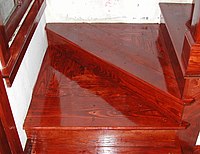
Photo from wikipedia
Two kinds of polyaniline (PANI) coupled graphitized carbon nitride nanosheets doped with different organic phosphoric acids (CP@PA, with phytic acid; CP@NP, with amino trimethyl phosphonic acid) were developed by in… Click to show full abstract
Two kinds of polyaniline (PANI) coupled graphitized carbon nitride nanosheets doped with different organic phosphoric acids (CP@PA, with phytic acid; CP@NP, with amino trimethyl phosphonic acid) were developed by in situ polymerization. According to the analysis of the section morphology and element distribution of epoxy resin (EP) composites, although CP@PA and CP@NP show completely different morphology, they can significantly enhance the dispersion of graphitized carbon nitride nanosheets in EP. In addition, the different oxidation states of phosphorus contained in the CP@PA and CP@NP lead to varying effects on the fire safety of EP composites. The flame retardancy Index (FRI) was a dimensionless index to evaluate the performance of flame retardants. When used as a flame retardant, CP@NP (FRI = 3.22) is better than CP@PA (FRI = 1.29) in flame retardant, especially in suppressing thermal hazards. As a synergist of intumescent flame retardants, CP@PA (FRI = 26.12) is the most effective in improving the comprehensive fire safety property of epoxy resin and achieved an "Excellent" rating. Therefore, two different flame-retardant mechanisms of CP@PA and CP@NP were summarized by analyzing the combustion behavior of EP composites and the change of condensed phase. In summary, this research may be helpful for the future design of nano synergies for intumescent flame retardant systems. This article is protected by copyright. All rights reserved.
Journal Title: Macromolecular rapid communications
Year Published: 2023
Link to full text (if available)
Share on Social Media: Sign Up to like & get
recommendations!